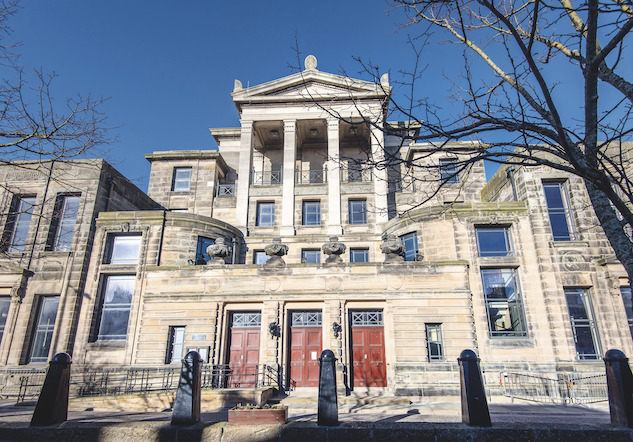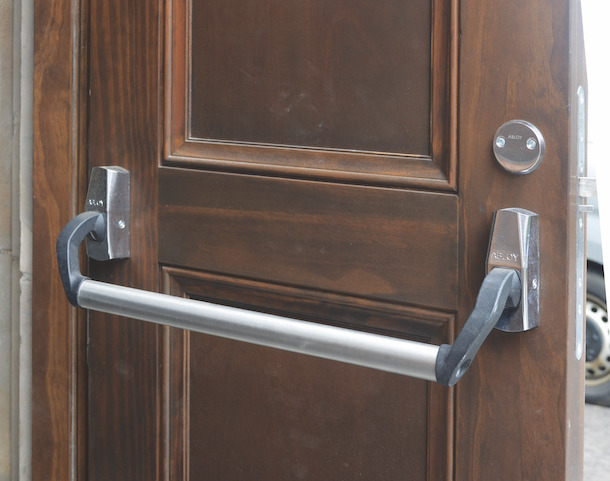
A trio of leading industry names collaborated to provide the University of St Andrews with a compliant access control solution for the refurbishment of Younger Hall. Younger Hall is the main venue for graduation ceremonies at the University, located in the centre of St Andrews. It is named after James and Annie Younger, local philanthropists and benefactors of the University.
It was designed by English architect Paul Waterhouse, built in the 1920s. Its design combines aspects of Neo-Classical and Art Deco styles, and the hall was recently renovated as part of a £12m project.
The project had several requirements, including matching the existing traditional doors with both non-fire and fire rated doors, along with compliant access control ironmongery. Abloy UK, Aspex and Johan Doors supplied the solutions.
The specification was challenging, as what might work from an ironmongery perspective and user functionality may not offer the best lifespan of the doors. Due to the historic nature and design of the building, the University was not able to use the standard Abloy EL560 locks normally specified on campus for the external doors.

The quality and design of the internal doors was to a very high standard, creating a challenge to install the cabling required for electric locks. There was also the added pressure that the heritage aesthetic needed to be retained, and there was no standard size of any internal or external door.
The external double leaf doors presented the most difficult part of the project, as they were extremely narrow, and the options considered would not work on this particular application.
Aspex worked closely with Johan Doors and Abloy to offer compliant installation on double doors that had a narrow leaf. Abloy proposed the PE590 motor lock with a PBE002 panic bolt. This configuration allows for the panic bar to be cut to suit the reduced width of the doors, providing a compliant and safe solution for these doors.
The correct specification and finish
Most of the doors in Younger Hall had been in place since the 1920s, and one side of the building was more exposed to sunlight. This had caused the doors on this side to drastically fade more than the other side, and the doors which sat centrally were a darker tone. The ironmongery specified also needed to meet current building regulations and practicality for everyday use, while considering the heritage surroundings and volume of people visiting the building.

To get the correct finish, Johan Doors used solid walnut, and after several samples they found a stain to use on certain locations along with frames and detailed architrave. Johan Doors prepared the doors and supplied Abloy compliant satin brass levers to complement the walnut door finish, which were installed by Aspex along with the compliant Abloy locks.
As a heritage project, doors had to blend with the existing appearance of the environment. The design had to be carefully considered to also allow for the positioning of panic bars or electric locks while mirroring the doors already in place, without compromising safety considerations in terms of mounting heights and operation.
Doors requiring electric locking had to be manufactured to allow for electrical wiring from the Abloy lockcase through the centre of the door, into the concealed door loop and through the frame.
Although this is quite simple on a flush door, on a solid mortice and tenon door with joints and panels, quite a lot of detail and drawing is required ahead of manufacturing to ensure the longevity of the doorsets.
Heritage combined with technology
Louie Woodland, director at Johan Doors Ltd, explained: “We all wanted to give the best result for the contractor and end client, so being open minded was essential to working collaboratively, and pulling together to ask, ‘how do we get this done?’
“We have had great feedback from the estates project manager in charge of the Younger Hall redevelopment. The need for heritage doors combined with technology has never been greater; it’s a beautiful traditional building, and yet the heritage doors with modern technology does not look out of place.”

Pauline Brown, associate chief information officer, University of St Andrews, commented: “The refurbishment of Younger Hall was no ordinary capital project for the University. Maintaining the integrity and historic nature of the building was critical, right down to the detail of the ironmongery. We’re so grateful to Aspex, Abloy UK and Johan Doors for working together to find appropriate solutions that continued to meet our requirements.”








